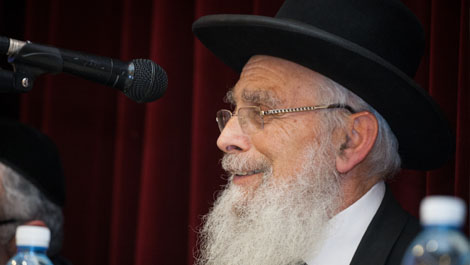Beit Midrash
- Sections
- Chemdat Yamim
- Igrot Hare’aya
Recipient: Rabbi Yehuda Leib Felman, an uncle of Rav Kook.
Body: I will relate to the dispute between the leaders of Israel, who are kollel heads. (In those days, the members of the religious communities in Eretz Yisrael received support from the Diaspora. The fundraising and distribution were done based on communal affiliation, based on country of origin or religious subgroup. Each group was called a kollel.) I have been upset since I heard of the dispute from the person in charge of Kollel Chabad, a very distinguished man from Yerushalayim, may it be rebuilt, who asked for my advice on the matter. My opinion is that we must all exert ourselves fully to prevent any further divisiveness, as the existing acrimony is enough and unfortunate. It would have been better to do away with the "addresses" (of the offices of the kollel funds), just so that a division should not be made, by which Chevron will be by itself and Yerushalayim by itself.
It is even more certain that there should not be even the slightest resentment in the heart of some of our brethren, which diminishes the level of sanctity of Yerushalayim, heaven forbid, in relation to that of any of the other cities. That would be the same moral blemish that is behind the prohibition to offer sacrifices on altars outside of the Beit Hamikdash. The protest against the tribes of Gad and Reuven when they built an altar (Yehoshua 22) was all about not equating the sanctity of any place, even in Eretz Yisrael, to the sanctity of the place that Hashem chose and with which His Name is associated. Certainly it should not be diminished from its lofty status.
It is specifically Yerushalayim and no other city which "contains" all that is in Eretz Yisrael. Therefore, the sanctity of Chevron is included in that of Yerushalayim and not vice versa. This is the basis of the Zohar’s (Chayei Sarah 128b) statement that all of Eretz Yisrael is "folded up" under Yerushalayim, which explains the name s’dei hamachpela (the double field). So we see that even the sanctity of Chevron and Me’arat Hamachpela, which is its spiritual focal point, is included in Yerushalayim, and Yerushalayim is the source of Chevron’s sanctity. This is what Rav Betzalel Ashkenazi meant when he said (Shut 14): "If there is no Yerushalayim, there is no Chevron." While the Chatam Sofer (Shut II:233) did not understand how the two are related, it does seem to be based on this piece in the Zohar.
It is true that setting the calendar is not linked specifically to Yerushalayim, as it can be done anywhere in Eretz Yisrael (see Berachot 63a). It is just preferable to do it in the portion of the Tribe of Yehuda, because this is the place of "for His Presence you shall inquire," and the portion of Yehuda is in proximity to that holy place (see Sanhedrin 11b). Tosafot (ad loc.) asks about a contradiction between the gemara that derives the place of setting leap years from "from Zion shall emanate Torah" and another gemara, which derives it from "for His Presence shall you inquire." The idea is that "from Zion …" teaches about Eretz Yisrael in general, which is sometimes called Tziyon and Yerushalayim. The other pasuk refers to the portion of Yehuda. In any case, we learn from both gemarot that the main sanctity and stature of Eretz Yisrael depend on Yerushalayim, for the simple wording of the p’sukim are always very telling, and they speak of Zion and Yerushalayim. It must be that the sanctity of Yerushalayim shines throughout the Land and that Yehuda is prominent because of its proximity to it.

Igrot Hare’aya (200)
Beit Din Eretz Hemda - Gazit
31 - Praise for a Book on Agricultural Halacha
32 - Yerushalayim First and Foremost
33 - Yerushalayim First and Foremost part II
Load More

Good Work, Regrettable Language – #330
Date and Place: 21 Elul 5670 (1910), Yafo
Beit Din Eretz Hemda - Gazit | Sivan 5785

Involving Baron Rothschild in Religious Efforts – #278
Igrot Hare’aya – Letters of Rav Kook Date and Place: 14 Adar 5670 (1910), Yafo
Beit Din Eretz Hemda - Gazit | Cheshvan 5785

Possibilities of Creating Religious Moshavot – #284 – part I
Date and Place: 1 Adar II, 5670 (1910), Yafo
Beit Din Eretz Hemda - Gazit | Kislev 5785

What Requires Protest? – #279
Igrot Hare’aya – Letters of Rav Kook Date and Place: 15 Adar I 5670 (1910), Yafo
Beit Din Eretz Hemda - Gazit | Cheshvan 5785

Beit Din Eretz Hemda - Gazit

Repercussions of a Sale That Turned Out Not Happening – part II
(based on ruling 83045 of the Eretz Hemdah-Gazit Rabbinical Courts)
18 Sivan 5784

A Commercial Rental for a Closed Business – part II
based on ruling 80047 of the Eretz Hemdah-Gazit Rabbinical Courts
Shvat 1 5782

Interceding Regarding a Will
Igrot Hare’aya – Letters of Rav Kook #105
Sivan 28 5782





















